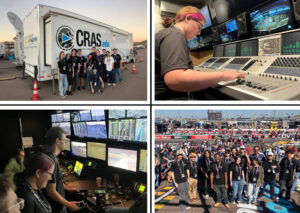CRAS Students Train On-Site in Real Time During Live 2025 NASCAR Championship Race at Phoenix Raceway
Story Highlights
The only things faster than the racecars during the Nov. 2 NASCAR Championship in Phoenix were the audio and video feeds.
 Students from the Conservatory of Recording Arts & Sciences (CRAS), an institution for audio engineering education, once again had the opportunity to learn live mix techniques from professional NBC Sports audio and video engineers in real time before and during the annual event at Phoenix Raceway in Avondale, Ariz. Students also had the opportunity to practice mixing live audio and video feeds from the host broadcaster in the school’s 42-ft. remote-production mobile broadcast trailer during the race.
Students from the Conservatory of Recording Arts & Sciences (CRAS), an institution for audio engineering education, once again had the opportunity to learn live mix techniques from professional NBC Sports audio and video engineers in real time before and during the annual event at Phoenix Raceway in Avondale, Ariz. Students also had the opportunity to practice mixing live audio and video feeds from the host broadcaster in the school’s 42-ft. remote-production mobile broadcast trailer during the race.
“We had 10 students out each day, whereas they toured the track to see microphone positions and look at the pit road announcer booth,” explains Robert Brock, CRAS Director of Education. “At the broadcast compound, they toured and became familiar with the various truck units that are there for power, replay, graphics, and witness the massive amount of interconnects between the units. We are very thankful for NBC’s Bryan Korot (A1) and Steve Urick (submixer) and all of the other support staff for taking the time to teach our students during such busy set-up and the real-time broadcast. This was an invaluable professional education.”
Adds Korot, “I so enjoyed having CRAS with us during our championship week. I love teaching our future audio team members and having their eyes widen as they enter our world. I still wish I had CRAS when I decided to go the audio route as the chance of shadow mixing a live national broadcast is an opportunity I wish I had early in my career.”
CRAS subdivided the group into 2-3 students, giving them the opportunity to mix audio of the race in real time using the same audio sources NBC was using, but without the pressure of mixing live on air. They also were in the A1’s (Korot) control room as he was working on air.
“NASCAR is so big they have another submixer position that mixes the audio associated with all of the track cameras,” Brock continues. “Students also had the opportunity to go into the Robocam operators room. Those cameramen remotely control track cameras from a mobile truck in the broadcast compound.”
The participating CRAS students were blown away with the complexity of airing such an enormous sporting event.
“I loved everything we got to see and be a part of for NASCAR,” says CRAS student Serena Tacho. “It opened my eyes to the world of broadcast…I enjoyed the energy from everyone and liked the chaos. I now have a much deeper appreciation for every live show and can see myself involved in it in the future.”
Adds CRAS student Toriano Adame, “I am very grateful to have had this experience and to see a bit of how the ‘behind the scenes’ works for these events. Being in the broadcasting compound has brought a lot of understanding and appreciation for all of the work and coordination needed to make shows like NASCAR happen. One thing that surprised me is how seamless and polished the communication is between each trailer and how it brings the ultimate delivery to viewers.”
CRAS student Jonathan Granados says that the fast paced movement of the production room was exciting and trying to mix it in CRAS’ production truck. “It was also informative to see the robotics camera movement and the amount of fiber optic lines that were run right in front of us to the track. It was very inspiring to be there and take part and witness people operate at such a high level.”
CRAS student Amellea Campbell concludes, “Being able to be on site at a major event such as the NASCAR and learning from the incredible engineers whom have put in the work to make this happen is truly inspiring.”
The Conservatory of Recording Arts & Sciences is composed of two nearby campuses in Gilbert and Tempe, Ariz. A CRAS education includes broadcast audio, live sound, film and TV audio, music, and video game audio, all taught by award-winning instructors who have all excelled in their individual fields, including sound reinforcement, audio recording and production, digital recording, troubleshooting/maintenance, and music business.
CRAS structured programs and highly qualified teaching staff provide a professional and supportive atmosphere, which is complemented by its small class sizes allowing for individual instruction and assistance for students in engineering audio recordings. CRAS has been providing quality vocational training in audio recording for more than three decades. The curriculum and equipment are constantly being updated to keep pace with the rapid advancements in the music and sound recording industries. CRAS’ course offerings and subject matter have always centered around the skills and knowledge necessary for students’ success in the audio recording industries.
The 11-month program is designed to allow every student access to learn and train in all of the Conservatory’s studios, which are comprised with state-of-the-art audio recording and mixing gear, the same equipment used in today’s finest studios and remote broadcast facilities, including Pro Tools 12, API Legacy consoles, SSL AWS consoles, Studer Vista consoles, and much more. All students must complete a 280-hour industry internship to graduate from the Master Recording Program II that may ultimately lead to industry employment.
